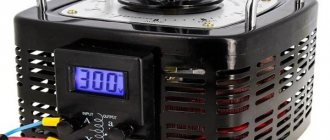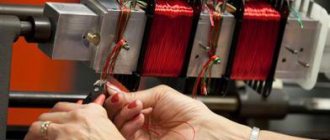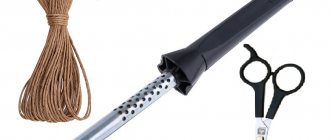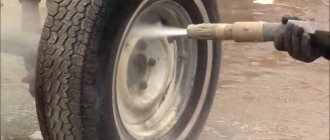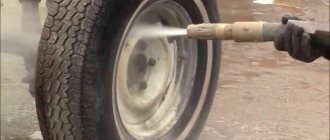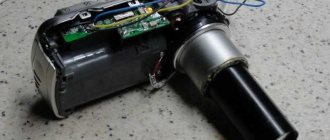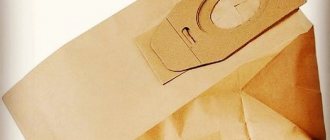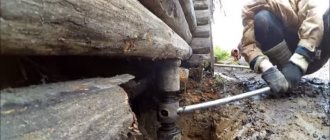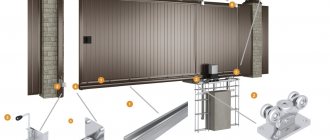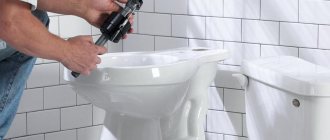Remove the coil from the trimmer
On small electronic trimmers with a bottom-mounted motor (when it is located near the ground when operating), the coil usually has two buttons on the edges. Click on them and disconnect one half of the coil body from the second, which remains on the trimmer . Together with the first half, the inner part is also removed, onto which the fishing line is wound. When disassembling, be careful: there is a spring inside that can fly out and get lost.
On electronic and gasoline trimmers with a bent rod (on such trimmers there is still no ability to place a knife), you need to grab the coil body itself with one hand, and with the other hand you need to start turning the thumb on it counterclockwise. Specifically, he attaches the coil to the trimmer rod. Having unscrewed the thumb, carefully remove the entire coil, trying not to lose the spring inside.
On electronic and gasoline trimmers with a straight rod and a gearbox at its end (on such trimmers, in addition to the fishing line, you can also install a knife), look for a hole under the coil, insert, for example, a screwdriver into it, quietly rotate the coil until the screwdriver gets even deeper , and the coil will lock. Now we twist the entire coil clockwise (because the thread is left-handed) and remove it from the trimmer. Next we disassemble the coil. It can be assembled using latches or twisted with a lamb. If the coil is on latches, then press along the edges on the base of the latches so that they bend and release one half of the coil body from the other. We just twist the lamb. There may also be a third type of connection of two halves of such a coil: with it you need to grab the lower part with one hand, and the upper part with the other, and begin to turn them in the opposite directions. When disassembling such a coil, you must also ensure that the spring inside is not lost.
Instructions with a step-by-step description of how to wind the coil of a trimmer and lawn mower
In order not to make a mistake in choosing the appropriate fishing line for your tool, you should first disassemble the head and look at the side wall of the reel. This information is usually presented on a tip, which will not allow you to make mistakes when using the appropriate equipment.
If there is information on the reel about what diameter of fishing line can be threaded, then this information can be clarified in the instructions. Having decided on the thickness or diameter of the equipment, all that remains is to figure out how to charge it. There are two ways to do this, but they are not applicable to everyone. Let's consider both methods in detail, and depending on what models of lawn mowers and trimmers you use, decide for yourself which option is suitable.
This is interesting!
The principle of how to wind a fishing line onto a brush cutter is appropriate not only for autonomous gas-powered units, but also for electric trimmers.
How to properly wind fishing line onto a trimmer reel
Many, having developed a factory fishing line on a recently received trimmer
, they try to wind the newest one, but they cannot, because they do not know how to correctly wind the fishing line onto the trimmer reel (spool). No matter how there is an abstract, it still doesn’t come out. Let's try to deal with this issue in this article.
So, in order to wind the fishing line, you must first remove the reel from the trimmer - it will be more convenient. The removal method will depend on the type of trimmer.
Line selection
In order to easily wind the fishing line onto the trimmer reel, you should decide what tasks the garden tool will perform. The thicker the thread threaded into the head, the more complex the tasks it can perform. It should be noted that a universal thread is often used, the width of which does not exceed 2 mm. You, in turn, can determine the size using the following methods:
- read the information contained in the instructions from the manufacturer;
- check the suitability of the fishing line for use yourself by trying to insert it into the hole of the reel;
- examine the spool for information about the diameters acceptable for use.
The selection of fishing line for threading into the trimmer reel can be done according to the type of engine. For example, an excessively thick thread can cause an increase in rotational resistance. Because of this, the load on the engine will increase, which will certainly affect the quality and timing of its further operation.
Avoiding negative consequences is easy. To do this, you need to take into account that for electric motors with a power of up to 500 W, a fishing line with a diameter of up to 1.2 mm is ideal. If you cannot get such a thread, you can use a 1.6 mm cord. A thread with a diameter of 2 mm, in turn, is used for engines with a power of more than 1 kW. It is worth noting that 2 mm cord is often used for winding on a curved mower. If a gasoline device has a straight shaft, you should use a 2.5 or 3 mm thread. The thickest fishing lines are installed exclusively on devices whose power is equal to or greater than 1.3 kW.
Last but not least important factor is the type of line section. When choosing it, you should focus on the tasks assigned to the garden tool. There are several popular cross-section options:
- twisted - has a small margin of safety, which is why it is suitable exclusively for young grass;
- jagged - characterized by sharp edges, suitable for working in areas overgrown with weeds;
- round is the most common cross-section. Such fishing lines cope well with fresh grass, but are not suitable for bushes and dead wood;
- rectangular, square and star section types - due to their low strength, they are used for working on lawns.
The most durable and versatile cord is a two-component fishing line with a round cross-section, inside of which there is a core. This is the thread that is suitable for most work. It must be remembered that the use of fishing line, ordinary wire and other third-party materials as a cord poses a danger to others.
Winding process
If your reel is designed to work with only one antenna, then everything is very simple. It is necessary to unwind 2-4 m of fishing line (depending on the size of the reel), find a hole on the inside of the reel that secures the fishing line, insert one end of the fishing line into it and begin to wind the fishing line in the direction opposite to the direction of rotation of the reel on the trimmer
. On the inside of the reel there is usually an arrow indicating which direction to wind the line. Having wound the fishing line, we leave a small piece of it unwound in order to expose it outside. We fix this piece in a special groove located on the inside of the reel and created so that the line does not unwind when the reel is assembled. If there is no such groove, then you will have to hold the line with your finger to prevent it from unwinding during the upcoming assembly of the reel. Next, take the outer part of the reel and thread the outer piece of fishing line into the existing hole, assemble and put the reel back on the trimmer.
If the coil is designed to work with 2 antennae, then do the following. On the inside of the reel we look at how many grooves there are for winding fishing line. There may be one or two. If there is only one groove, then both tendrils are wound along this one groove. If there are two grooves, then each tendril is wound along its own groove. A reel with one groove must have a through hole through which the line
.
We unwind 2-4 m of fishing line, thread it through this hole so that the fishing line sticks out identically on each side. And we wind both tendrils of the fishing line at once in one direction, the opposite direction of rotation of the reel on the trimmer
and coinciding with the direction shown by the arrow on the inside of the reel. We leave a little of the fishing line unwound, secure the resulting ends in special grooves, and if there are none, hold them with our fingers. We thread both ends into the existing holes on the outer body of the coil. We assemble the coil and attach it to the trimmer.
If there are 2 grooves, fold a piece of fishing line 2-4 m long in half, insert the resulting loop at the bend into the groove between the 2 grooves, and immediately wind both ends of the fishing line, each along its own groove. Subsequent actions are similar to the previous version.
There are also reels in which the line is threaded through a through hole on the inside. After that, the ends of the fishing line, without winding, are threaded one hundred percent through the holes on the outer body of the reel, assemble the reel and begin to twist the button, which is usually pressed, so that during operation the fishing line is released as it wears out. You turn the button and the fishing line winds itself inside. With all this, you won’t be able to spin it in the “wrong” direction, because it can only spin in one direction. If you get used to it, you can wind it
line, without even disassembling it - you just need to combine the through hole of the inner drum with the holes on the outer body of the reel, and then thread the line into them.
READ What Line Do You Need for a Bosch Trimmer?
That's all on this issue. Happy winding!
String breaking
Constant line breaks are caused by:
- the presence of hard objects in the mowed grass: branches, pebbles, etc., contact with which breaks the string;
- mowing the grass close to the fence, and if it is mesh, then the fishing line
breaks even faster; - low-quality cord - needs to be replaced with a new, reliable consumable;
- wear of the outlet holes in the mowing head, as a result of which the fishing line breaks due to friction against the sharp edges of the bushings - the part needs to be replaced with a new one.
Method 2 - how to properly put fishing line on the reel of a lawn mower with photo description and video
The second method differs from the first in that the coil is charged not with a single piece of equipment, but with pieces of two parts. Manufacturers use this method, and it is also suitable for those who have leftover material. The principle of how to insert two pieces of fishing line into the tip of a lawn mower is the same as the first method, and to make sure of this, below are detailed instructions:
- There are two equal length pieces of material that can be used
- One piece is taken and the edge is bent in the form of a clamping bracket or hook, with the help of which the fishing line will be secured
- Inside the coil there are holes in the form of a bracket for fixing, which are there for a reason. If they are not there, then the second option will not work. The appearance of these brackets is shown in the photo below. Each bracket is on its own half
- The fishing line should be hooked onto the bracket and reeled in in accordance with the direction of the arrow.
- The equipment is wound until a 10-15 cm segment remains, which is fixed in the corresponding hole on the side of the aiming
- Manipulations with the second end of the fishing line are carried out in a similar way.
- The protrusions are inserted into the holes of the head, and then, removing the equipment from the temporary fasteners in the reel, the cover with clamps is installed
The above instructions on how to install a fishing line in a lawn mower will help not only correctly, but also quickly carry out the replacement procedure. Assembling the trimmer coil, as mentioned above, can be done without removing the head, but in this case you will need to conveniently fix the tool. Video instructions are presented below.
Preparing to replace fishing line
Before replacing the fishing line, you must remove and then disassemble the head. Usually it contains a casing, a spring (on some models), a bobbin with fishing line, and a cover. You need to unplug the electronic trimmer (or turn off the gas trimmer), then proceed to remove the coil. It can be fixed using 2 different methods: in the first case, you need to completely disassemble the head, and in the 2nd case, you just need to remove it from the gearbox shaft on which it is attached.
- find the latches on both sides, press and remove the cover to open the internal structure of the head;
- there is a bobbin under the cover, it must be carefully removed from the case (from time to time a spring is hidden under it, it should also be carefully removed to the side so as not to be lost);
- after removing the spool, a fixing bolt (or screw) becomes noticeable in the center of the body, which must be unscrewed in the direction opposite to the clockwise movement;
- After removing the fasteners, it is necessary to hold the body by the body and remove the coil from the gearbox shaft with rocking movements.
The 2nd method involves subsequent actions. The coil head is mounted on the gearbox shaft. To disconnect it, you need to lock this shaft. Usually in braids, for example, brands “Champion” or “Stihl”, for this purpose a hole is made into which a nail, rod or screwdriver is inserted. After fixing the shaft in a stationary position, it is necessary, holding it by the body, to start turning the head clockwise, because the thread on the shaft is usually left-handed.
Now that the head has been removed and disassembled, we need to find how thick the cord should be. You can find out the appropriate diameter for your own trimmer by looking at the user control or at the bobbin itself; usually similar information is indicated on it. The next method is to stick the thread into the hole from which it is fed. If shit goes without any difficulty, it can be used for work.
The string doesn't hold
If the spring in an automatic reel weakens, the line does not hold and unwinds during operation. The cord is pulled out, cut with a knife, and as a result, the owner of the equipment notices that the thread is quickly running out.
Types of trimmer heads
The grass mowing head is a cylindrical body in which the reel
(spool) with fishing line (cord) tucked into it. This design can be installed on both gasoline and electric trimmers. The heads differ in the method of threading and feeding the cord and there are 3 types.
- Automatic. The cord is fed after the user reduces the engine speed. Although automatic line feeding is convenient if large volumes of work are performed, such bobbins have one drawback - high thread consumption.
- Semi-automatic. The use of this type of head does not require the user to perform complex manipulations. The principle of their operation is designed in such a way that the cord is extended automatically while the device is operating at full speed. It is enough to lightly hit the trimmer head on the ground (this removes the blockage of the cord), and the fishing line, thanks to centrifugal force, moves out of the spool, after which it is cut to the required length with a knife located on the protective casing.
- Manual. To lengthen the cord, the machine must be stopped, after which the line is pulled out manually.
Based on the above, semi-automatic bobbins are the best option. It should also be taken into account that trimmer reels can be single-string (used only for trimming grass) and double-string, which are used for mowing tall grass and small, thin-stemmed shrubs.
Read also: Do-it-yourself cable routing in an apartment
Fishing line - varieties and the possibility of replacement with other material
The cord for the trimmer can be of different diameters (from 1.2 to 4 mm), and it must be chosen depending on what kind of vegetation needs to be mowed - the thicker the line, the coarser the grass it will handle. Experienced users advise using a fishing line 2 mm wide, which is universal.
The shape of the fishing line can be round (for juicy grass) or with sharpened edges in the form of a square or star (for mowing dry grass). Type 2 is the least durable and wears out more quickly compared to round cord.
One of the favorite questions regarding the operation of trimmers is whether it is possible to replace the special cord for mowers with other materials, for example, iron or iron cables and strings, wire, etc. You need to know that installing such items is not recommended, since together with them the trimmer turns into a terrible technique. During the mowing process, pieces of wire or metal will constantly break off and fly in different directions, risking injury to the worker. And if you accidentally touch your limbs while working, severe injury is guaranteed.
For owners of trimmers who are interested in whether it is possible to use fishing line, we answer - this is allowed, but it will tear and wear out even faster, which means that it will require frequent replacement.
How to properly change line on a trimmer
A trimmer is a successful and easy-to-use tool for cutting grass and trimming small bushes and trees. Fishing line is often used as a cutting element.
(string, cord), since it costs less than disc knives and is less dangerous to use.
If you use the tool intensively over time, you will need to change the line on the trimmer
. This process is similar on mowers from various manufacturers, be it Husqvarna or Huter, with likely minor differences.
The fishing line flies out
If the string flies out when mowing, this is another evidence that the spring in the bobbin has weakened or was completely lost due to careless disassembly of the head. Ultimately, the cord does not hold and pops out when rotated.
Changing fishing line to disk
The procedure for changing the fishing line to the disc in a brush cutter is as follows:
- Remove the protective casing from the rod;
- We block the trimmer drive shaft by threading a screwdriver through the hole in the gearbox bowl to the hole in the shaft hub;
- Unscrew and remove the spool of fishing line from the trimmer drive shaft hub;
- We install the cutting disc on the shaft, aligning the splines on the hub washer with the notches in the mounting hole of the disc;
- We lock the trimmer drive shaft again and tighten the fastening nut. It is advisable to tighten the nut with a tubular wrench, but do not overdo it;
- We put back the protective cover.
That's it, the lawn mower is ready to work with the cutting disc.
Important! Changing cutting elements must be carried out carefully, observing safety precautions. You must read the instructions and follow all the rules stated there. This will ensure productive, reliable and safe operation of the trimmer.
What is needed to replace the cord
With constant use of a trimmer to cut grass, the discs become dull, but they can be sharpened and continue to be used. The line in the reel tends to run out, so there is a need to refill it with a new one, why you need to find the type of head and prepare the cord of the required thickness and length.
So, the mowing head is a cylindrical body in which the spool with fishing line is located. This part is found both on electric trimmers and on gasoline scythes of all brands, be it Bosch, Makita, Stihl or another brand. There are 3 types of heads depending on the method of threading and feeding the line.
- The mechanism of operation of the automatic group heads is that they independently feed the fishing line when the mower reduces the engine speed. Such designs are comfortable when working over large areas, but have the disadvantage of high cord consumption.
- The heads of the automatic group are easy to use - automatic line feeding is carried out at the highest engine speeds. To remove the cord blockage, you need to carefully tap the equipment on the ground, after which the unlocked thread moves out of the spool. Cutting to the required length is done with a knife attached to a protective casing.
- Trimmers with manual line feed must be turned off first, and then remove the line without the help of others.
READ How to Wind Line on an Electric Gardena Trimmer
Reels for electronic and gasoline streamers can be with one or two tendrils of fishing line. The first ones are used for trimming low grass growth, the second ones are used for mowing tall grass and small bushes.
On a reel with one antenna
Winding the fishing line onto a reel with one tendril is not at all difficult. In such structures, depending on the brand of trimmer, from 2 to 5 meters of cord are placed. The edge of the fishing line in the spool must be tucked into a special hole or groove, after which the string is wound in the direction opposite to the rotation of the reel during operation.
After the fishing line is wound, you need to throw a small piece (15-30 cm), thread it through the outlet hole of the spool and reassemble the head.
High line consumption
Typically, the line ends very quickly if you constantly knock the automatic reel on the ground or press it forcefully against the surface. In this case, the head is unlocked, the cord is extended, and the knife cuts it. The second option for fast line consumption - a trimmer with an automatic reel is used incorrectly. If the mower often reduces the engine speed, the string is constantly lengthened and cut, and ultimately is rapidly used up.
Reel with two working antennae
In this type of spool, you should find the number of grooves for winding line lying on the inside of the reel:
- one groove - both tendrils are wound together along one groove;
- two grooves - each tendril is wound along a personal groove.
For both cases a fishing line 2-3 m long is taken. In single-groove reels the fishing line is pulled into a through hole, its ends (tendrils) are folded together and aligned, after which they are wound in the opposite direction of rotation of the reel on the rod - the correct direction of winding is usually indicated on the inside by an arrow. If there are locking grooves, the ends of the fishing line are threaded into them or held with the fingers of your free hand, threaded into the through hole of the outer half of the reel, the spool is locked and attached to the trimmer rod.
The difference between winding fishing line in two-groove reels is that first a piece of fishing line 2-5 m long is folded in half (to determine the middle fold), and the fold loop is inserted into a special groove between the grooves. Both antennae of the fishing line are wound each along their own groove; fixing the antennae and assembling the reel is similar to the option discussed above with one groove.
The first implementation of this procedure may seem long and quite labor-intensive, but with the passage of time and experience this problem will be solved much faster and easier.
The following will clearly show how to thread the fishing line into the trimmer reel and wind it correctly - this operation is not difficult and, with some patience, will certainly be crowned with success:
How does a head with a fishing line work on a brush cutter? Why do you need to know the principle of operation?
Depending on the manufacturer, the heads differ in design not only externally, but also internally. Most reels have a pressure spring inside (semi-automatic and automatic). Above are instructions on how to disassemble the trimmer head without a spring, i.e. on a manual type head. The principle of dismantling a semi-automatic head with a spring inside is almost identical to the instructions described above.
The operating principle of a semi-automatic trimmer coil is as follows:
- Inside the head there is a coil, which is seated on splines that prevent its free movement.
- The coil is acted upon by a spring, which presses it against the slots located in the cover structure
- A fishing line is wound around the tip, the length of which depends on the tool itself. Typically this length is from 1 to 4 meters
- During work, if it is necessary to increase the length of the fishing line, the protruding part of the drum is pressed, causing it to disengage with the splines. In this case, the fishing line unwinds from the drum, increasing in length
- Having released the required amount of fishing line, you should release the pressure and continue mowing the grass.
The advantage of a tool with a fishing line is that this consumable does not require sharpening, compared to metal discs. In addition, if a stone or tree gets in the way, the line simply comes off without negatively affecting the gearbox and engine of the tool, as is the case with metal cutting discs.
Knowing the design and structure of the types of mowing or trimmer heads, it is necessary to move on to consider the process of threading fishing line into the trimmer reel. After all, it is precisely this moment that causes difficulties for most owners of special tools.
We wind the fishing line
Slowly completed disassembly of the spool reel without losing its spare parts allows you to move on to the main task - winding fishing line into the reel. The technological features of the spool design and the number of working antennae determine the sequence of actions.
Want to save this? The first method of winding fishing line
The required amount of fishing line has been cut off. Now you need to carefully examine the bobbin to understand what type it is. It depends on how the fishing line is wound around it.
Bobbins come in two types. In general, they are not radically different from each other. Regardless of the type, the coil is divided into two compartments - upper and lower. In the first type, the dividing edge does not close into a ring and has a recess.
In the second type, it is solid, but there are small through holes near it at the edges on both sides. The method of winding thread must be learned depending on which of the types indicated above the reel belongs to.
- The previously prepared six-meter segment needs to be bent in half. The best thing is not exactly in the center, but in such a way that one half comes out longer by about fifteen cm.
- Then the bend must be inserted into the recess in the dividing edge. One half of the line should be at the top of the reel, the other half at the bottom.
- Now you can start actually winding. to wind in the direction that the arrow on the bobbin shows. When winding, it is necessary to hold the threads so that they do not intertwine and the upper half is wound into the upper part of the spool, and the lower half into the lower part. Each half should have about fifteen cm free from the end.
- At the top edge of the bobbin there are small recesses (or, in other words, grooves) for securing consumables. The ends of the threads must be inserted into these recesses so that they are secured one opposite the other.
- The final step of threading the consumables into the tool is to insert the ends attached to the bobbin into the appropriate holes in the trimmer head.
- That's all. The winding process is complete. Now all that remains is to assemble the head into a single whole. The spring is carefully placed back between the bobbin and the head. Then you need to insert the bobbin into the head and press them together.
- It is recommended to pull the free ends of the thread outwards as much as possible. To do this, you need to pull the ends of the consumables one by one so as to remove them from the bobbin grooves. You can make sure that the cutting element is removed from the retaining grooves by trying to slightly stretch the threads - they should come out unhindered through the holes in the head.
- While pressing the bobbin down, you need to put the cover on top of it. The cover must be screwed to the head so that all the grooves on their bodies align and the bobbin remains fixed between them.
- And finally, the very last step is to screw the head back into place at the bottom of the tool.
READ Trimmer Stihl Fs 250 Gasoline Consumption
The process is complete. The line is threaded into the reel. The trimmer is ready for the upcoming work.
Types of trimmer heads
The heads of the scythe can also have different devices: with automatic line feed, semi-automatic or manual. In the first case, in order to lengthen the working ends of the thread, it is necessary to slightly reduce the speed. And when you add them again, the line will extend automatically. For semi-automatic devices, you need to press the special button located below. It is not necessary to turn off the trimmer. It is enough to simply hit the scythe on the ground. The most inconvenient to use are trimmers with manual string feed. To lengthen its working ends, the tool must be turned off and the operation performed manually.
Another spool of line for the trimmer
It happens:
- single-string - suitable only for cosmetic trimming of the local area;
- two-string - used for more serious work on clearing the area of grass.
- A ring needs to be cut out of thin but durable plastic, and its inner diameter should be equal to the thickness of the core on which the fishing line is wound, and its outer diameter should be equal to the diameter of the reel.
- On the inside of the ring you need to make a small notch through which the thread will be threaded.
- Next, the ring is cut and put on the reel. And the incision site is glued with tape or soldered using a hot knife. That's all - now each end of the fishing line can be wound onto its own part of the reel.
Preliminary preparation
First, to wind the fishing line, you need to remove the reel (spool, spool) from the trimmer - certain steps will depend on the complexity of the configuration and the type of the product itself:
- small electronic trimmers with a working arrangement of the motor and coil in the lower part usually have side buttons on both sides of the reel. By simultaneously pressing them, the upper part of the reel, together with the internal contents for winding the fishing line, is disconnected, while the lower part remains on the trimmer
. It is better to disassemble the bobbin on a flat, smooth place so that the spring included in the structure does not jump out and get lost; - electronic and gasoline trimmers with a curved rod without the ability to install a knife usually have reels with a special wing: in similar designs, you should hold the spool in a stationary position with one hand, and with the other hand, turn the wing nut that locks the reel on the rod counterclockwise. After disconnecting the nut, the entire bobbin is removed.
- electronic and gasoline trimmers with the ability to install a knife on a straight rod (for example, Stihl trimmers) have a hole under the reel. To keep the rod stationary, a screwdriver or other suitable object is inserted into this hole, and with a slow rotation, such mutual placement is achieved when the screwdriver goes inside the hole and the reel is fixed. After which the coil body is rotated clockwise (with a left-hand thread) and removed from the trimmer.
For the second and third options, the coils, depending on the design, are disassembled using different methods. In reels with a lamb, the lamb is turned out, in reels with latches, the latches are pressed and one part of the reel is released from the other. If the halves of the spool are connected by thread, then it is enough to turn them by hand in the opposite direction until they are completely unscrewed.
Selection by thickness
In addition, special attention should be paid to the thickness of the consumable material. For mowing young grass, a thread with a diameter of about one and a half mm is suitable. The larger the diameter of the thread, the more dry and coarse weeds it can handle.
There is one “but” when choosing fishing line thickness. It is fundamentally not easy to evaluate the capabilities of the material, and to take into account the features of the trimmer. You should definitely look into the user manual that comes with the tool and find information about the requirements for the cutting element.
Inserting the wrong thread may result in tool failure. Using a very thick thread will overload the device's motor. And the introduction of a very narrow thread will significantly increase the wear of the rotating mechanism.
That’s why you need to approach the choice of consumables more carefully than when filling it into the trimmer. Once a suitable fishing line has been found and purchased, you can begin to consider methods for winding it onto a reel.
How to thread line into a trimmer
The method for winding thread onto a spool depends on the model of gasoline trimmer. In devices with a fishing line and in a sample with the ability to change the cutting element, the algorithm of actions is different. Let's look at each option separately. The diameter of the fishing line is indicated on the side of the reel or in the instrument’s passport. For winding, choose the fishing line specified by the manufacturer.
A fishing line with a diameter of 2 mm is considered universal. It is used for cutting grass of any hardness. The thicker the working thread, the harder the vegetation it cuts. But if you insert too thick a line into the reel, the engine will begin to overheat, as the resistance to shaft rotation will increase.
How to wind line on a trimmer reel
At first glance, threading fishing line into the reel of a tool is a complicated matter. But study this process quite closely - and in the future all the necessary actions will be carried out without any difficulties.
To find out how to thread the line into the trimmer, you should read this manual. The step-by-step instructions given below take into account the features of the coils of various types of trimmers, and therefore apply to any tool.
So, the procedure is as follows.
- The line spool is the bottom last part of the trimmer. First of all, of course, you need to remove this head from the device. To do this, it is necessary to fix the rod (or, in other words, the shaft) on which the coil is attached. You need to fix it in such a way that it does not scroll. The easiest way to do this is to place a typical stopper (ideally iron) between the threads of the shaft through a special hole. When the shaft is fixed, you can unscrew the coil.
- At this step, you will remove the bobbin from the head on which the fishing line
. To do this, you will need to disassemble the head into elements. To do this, you must first find the latch on its body. It is placed on the circumference of the product and is like a button. When the latch is found, you need to press hard on it. While holding the latch pressed, you need to turn the head cover clockwise. Then you need to remove the cover and remove the bobbin. - There is a tight spring between the bobbin and the head. It must be put aside for a while so that it does not interfere with the winding process. Before you begin the line winding step, you need to inspect the bobbin. If there are remnants of old fishing line on it, they need to be removed. Once the bobbin is cleaned, you can begin preparing a new skein.
- From a previously prepared skein of new fishing line, you need to measure and cut 6 (maximum seven) meters. The bobbin should be within reach.
At this point, the main stage, which is the subject of this article, actually begins.
Sources:
https://hitech-online.ru/tehnika-dlya-sada/trimmer/kak-menyat-lesku.html https://yasenevo-flowers.ru/navesnoe-oborudovanie/kak-pravilno-pomenyat-lesku-na-trimmere .html
How to choose a trimmer line
A trimmer bought in a store is already ready for use - it is loaded with a standard nylon fishing line. It cuts the grass, but does a poor job - it quickly breaks down and only mows down young, thin plants. It does not take old grass and weeds with woody stems at all or cuts them with difficulty, quickly wearing out. It only lasts for a short time, after which you need to replace the line in the trimmer.
It is not recommended to use fishing line; it is better to take a special thread with a fiberglass core. It is sold in construction stores. Opt for an option with a square or triangle cross-section - their sharp edges will work like knives.
The consumption of trimmer line when using faceted and reinforced consumables will be reduced by 2-3 times, and productivity will increase by the same amount compared to round line and line not reinforced with fiberglass.
Purchase material with a diameter no less than that recommended by the manufacturer. If the diameter is unknown, you need to look at the size of the holes on the outer housing of the mowing head: the diameter of the working thread should be slightly smaller than the hole in order to pass through it freely.
Buy a sufficient supply of cutting thread (for 2-3 replacements), try buying different options to compare which one will work best.
Having found out how much material is needed for one winding, be guided by the length of the line during your next purchases so that there are no pieces left too short for winding.
To replace the line on a mechanical scythe with your own hands, you need to disassemble the mowing head and remove the reel on which the working thread is wound.
